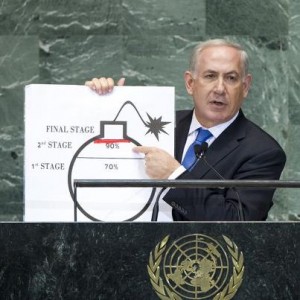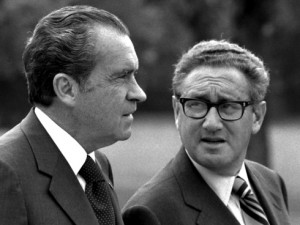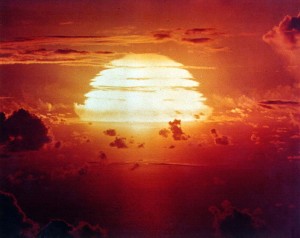Perhaps the height of Official Washington’s madness is the casual decision to invest $1 trillion in a new generation of nukes, including a downsized, easy-to-use variety, with almost no debate, a danger that Michael Brenner addresses.
By Michael Brenner
By now we are accustomed to bizarre foreign policy moves from the White House. The last 15 years have seen a series of initiatives that defy reason and good sense. The pattern is so well established that on the very rare occasions when a President follows a policy that is eminently logical – like Barack Obama’s decision not to bomb Iran – it is met with shock and awe.
Against this backdrop, the program to spend $1 trillion on developing an upgraded arsenal of nuclear weapons with expanded capabilities suggests a return to “normal” – that is, the bizarre. Yet this vast expenditure for no apparent strategic purpose has generated little debate whether within the Obama administration, political circles or the public.

A scene from “Dr. Strangelove,” in which the bomber pilot (played by actor Slim Pickens) rides a nuclear bomb to its target in the Soviet Union.
This fits a by now recognizable pattern: critical decisions are taken on matters heavy with consequence without explanation of why that course of action is chosen and it then goes unremarked by the politicos and media. That double failing is making a mockery of our supposedly democratic governance. Furthermore, it allows to slip under the radar costly – potentially dangerous – initiatives that cannot hold up under scrutiny.
We have 70 years of history with nuclear weapons. The accumulated experience includes decades of Cold War dealings with the Soviet Union, nuclear arms spread to nine other countries, the refinement of our thinking about all aspects of their strategic role, and rigorous exercises on the logic of deterrence, of coercion, and compellence. No subject has been received as concentrated critical examination.
The understanding and wisdom acquired, though, seems to have largely eluded those who have chosen to head down the path of elaborating our nuclear capabilities and doctrines for their use. Why? We haven’t been told. However, we have learned from leaks what are the features of this massive new nuclear program.
One, it aims to design and to build a class of small (in size and yield) bombs in the 5-10 kiloton range. Incorporating highly sophisticated engineering, it theoretically would be possible to adjust the “yield’ depending on the target and the purpose.
Two, these nuclear munitions could be packaged as precision-guided weapons deliverable from either stationery missile platforms or aircraft that would launch them as they currently do warheads with conventional explosives.
Three, these refined capabilities would enable them to be used against hardened targets such as underground nuclear facilities, against an enemy’s military installations or against other high value targets.
Four, by implication these are “first-strike” weapons; that is to say, their value is not to deter another nuclear armed state by threatening devastating retaliation, but rather to accomplish a mission either related to a conventional conflict or to eliminate an objective judged to pose a potential threat. Thus, this “new age” nuclear force represents a radical departure from what has become the “no first use” principle of nuclear strategy – in practice if not in treaty.
Some Basic Truths
To place this radical development in perspective, it is essential to remind ourselves of a few basic truths distilled from our collective experience of the nuclear era.

Peter Sellers playing Dr. Strangelove as he struggles to control his right arm from making a Nazi salute.
–When we speak of an encounter between two nuclear armed states, the weapons’ primary utility is to deter the other. The risk and consequences of nuclear war are so great as to outweigh any possible advantage in trying to actually use them as part of a military strategy. This holds for all binary pairs of nuclear states: India-Pakistan, Israel-Iran (conjectured).
The resulting condition of Mutual Assured Destruction (MAD) is stable when the following conditions are met: both sides have the capacity to withstand a first strike while retaining the means to deliver a nuclear riposte; and when there is the will to do so. No one has ever thought of testing the credibility of the latter. The exact modalities of the countries’ nuclear arsenals have no bearing on this fundamental logic.
This logic manifestly has been absorbed by everyone who has been in a position to order a nuclear strike. No civilian leader (or military commanders with a few exceptions) with the authority to launch a nuclear attack ever believed that the result would be other than a massive exchange – mutual suicide for those with large arsenals. This did not encourage risk-taking at lower levels of conflict. Just the opposite – for fear of escalation.
We have a contemporaneous account of Soviet leader Leonid Brezhnev visiting a Soviet ICBM site in the 1970s. The commanding general demonstrated to him exactly what the launch procedures would be were Brezhnev to punch in the codes that set the process in motion. For demonstration purposes, he was offered the opportunity to push this or pull that which would release the missiles if they had not been deactivated. Brezhnev’s hand began to shake, he broke into a cold sweat and he asked for reassurance three times that in fact the system had been deactivated.
We have abundant first-person evidence of how deeply engraved this inhibiting logic is. One example is from President Richard Nixon’s effort to persuade the Soviet leadership through hints and gestures that unless it applied its full weight on Hanoi to accept terms of a settlement satisfactory to Washington, he Nixon might consider a resort to battlefield nuclear weapons.
Nixon and National Security Advisor Henry Kissinger went so far as to call in Ambassador Anatoly Dobrynin to convey the message personally in the hope of scaring him and the Kremlin leadership. The Soviets ignored the menace as a bluff lacking all credibility. (See the account in Nixon’s Nuclear Specter: The Secret Alert of 1969, Madman Diplomacy, and the Vietnam War by Jeffrey P. Kimball & William Burr)
First Use?
–That raises the question of whether Washington has an interest in keeping open the option of making first use of nuclear weapons against Iran or North Korea. It is not at all obvious that these doctrinal nuances have any practical meaning other than as post hoc rationales for decisions taken for different reasons.
Preemptive nuclear strikes are highly risky since one never knows with certainty that they will disarm an enemy and prevent them from responding in other highly disagreeable ways. Think of 20,000 North Korean artillery pieces trained on Seoul. Think of Iran’s several opportunities to wreak havoc in the Gulf.
–First-use – even as doctrine – also sets dangerous precedents. It weakens the nuclear taboo entrenched since 1945, and it thereby heightens anxiety in a manner that increases the risk of accidental or miscalculated use.
–The smaller the caliber of nuclear arm, the greater the temptation to devise military doctrines for their use – despite the experience of the past 70 years and the logic outlined here. So-called Tactical Nuclear Weapons (TNWs) are inherently dangerous.
TNWs have a long history – both as to their inclusion in arsenals and in strategic thinking. This history, though, is now being ignored, whether neglect is due to inattention or to intentional dissimulation. The net effect is the same. There was a military reason why the United States was attracted to TNWs. In the context of Mutual Assured Destruction – or mutual dissuasion – wherein the resort to nuclear weapons leads inexorably to massive exchanges amounting to total destruction on both sides, the one with superior conventional forces possesses a theoretical advantage.
That is to say, it could overwhelm the weaker party, present it with a fait accompli, and expect that there would be no nuclear riposte since that would mean mutual destruction. In theory. The seeming answer: TNWs which, it was hoped, could be used to counter a massive conventional attack without triggering an all-out nuclear war. The risk of that happening, in turn, deters the would-be conventionally superior attacker – as does the fear of uncontrolled escalation.
However far-fetched, this was official American/NATO strategy in Europe from 1960 until the Cold War’s end. Our strategy, our force configuration, our contingency plans in Europe were all formed by this concept. We built thousands of TNWs of various calibers (including nuclear mines and shells that could be shot from artillery) and spread them around Europe and Korea. Whether and under what conditions they might be detonated always was obscure. It was a question that faded with stabilization of the nuclear relationship with the USSR. Under post-Cold War arms control agreements, they have been withdrawn.
Today, Pakistan military planners worry that they are facing an analogous dilemma in contemplating a conventionally superior India. Their strategic thinkers are pondering the idea of developing and deploying TNWs as deterrent/defense reinforcement. India, as did the Soviets, is pondering how it might counter such an eventuality: strike first with TNWs to neutralize those in the Pakistani inventory or warn that any first use likely would lead to mutual suicidal resort to strategic nuclear weapons.
The risk of nuclear war by miscalculation is greater in South Asia than it was in Europe. For geography characterized by the contiguity of the protagonists reduces warning times and immediately endangers national integrity. In addition, the absence of invulnerable Submarine Launched Ballistic Missiles (SLBM) undermines the credibility of massive retaliation as a deterrent to first strikes.
Why Press Ahead?
So what is the point of constituting a high-tech nuclear force now to be centered on TNWs, precision-guided munitions and low-yield warheads? There is no conventionally superior, or equal, potential adversary out there. The United States enjoys conventional superiority over all conceivable enemies. So, the scenarios are quite different.
Pentagon military planners and their obedient White House “overseers” obviously have Iran and other possible ”rogue” states in mind – that is to the extent that strategic considerations of any kind lie behind the program’s development. For the driving forces are more likely to have been a dedication to technological along with powerful bureaucratic interests.
Let us assume, for the purpose of this logical exercise, that whatever strategic thinking has been done was not simply post-hoc justification. Can the inferior nuclear state deter the superior nuclear state from launching conventional attacks?
We do not have much data on this – especially since there is no case of the superior state trying to do so. Would an Iran with a rudimentary nuclear arsenal be able to deter an American or Israeli-led assault a la Iraq by threatening troop concentrations and/or fleet elements in the Persian Gulf? We certainly can say that it would heighten caution. An inferior nuclear state might wish to instill anxiety that its weapons could be activated accidently at the height of a crisis – thereby deterring a superior (nuclear and/or conventional) antagonist from pressing its advantage.
A similar logic points to cultivating an image of being ‘irrational.’ Would the United States have invaded Iraq if it believed a “crazy” Saddam had three or four nuclear weapons? Would it consider aggressive action against Iran if it believed the “mad Mullahs” in possession of three or four nuclear weapons? Not sure. But what bearing would upgraded TNWs have on this calculus? None.
If the inferior state (e.g. North Korea) has the ability to deliver a nuclear weapon against the superior’s homeland, that cautionary element grows by several factors of magnitude. Again, in theory. Again, TNWs add nothing to deterrence.
A second question: Can the nuclear state provide a credible deterrent umbrella for an ally that is conventionally inferior to a superior armed enemy? (Western Europe facing the Red Army; Saudi Arabia facing Iran circa 2040). The NATO and South Korea experience says ‘yes.’ That is, if the stakes are highly valued by the state providing the “nuclear umbrella.” Again, the risks of escalating to nuclear exchanges have a conservative effect on everyone. Two things deter: certainty; and total uncertainty.
Here is one general thought about extended deterrence as a “generic” type. Throughout the Cold War years, the United States and its strategically dependent allies wrestled with the question of credibility. Years of mental tergiversations never resolved it. For one intrinsic reason: it is harder to convince an ally than it is to convince a potential enemy of your readiness to use the threat of retaliation to protect them.
There are two aspects to this oddity. First, the enemy has to consider the psychology of only one other party; the ally has to consider the psychology of two other parties. Then, the enemy knows the full direct costs of underestimating our credibility and, in a nuclear setting, will always be ultra conservative in its calculations.
By contrast, the ally that has not experienced the hard realities of both being a possible target of a nuclear attack and the possible originator of a nuclear attack cannot fully share in this psychology. Is this last observation a point in favor of developing a more refined first-strike capability? No. For one thing, given the disproportion of forces, there is no conceivable gain from the conjectured fine-tuning. For another, the risk of nuclear proliferation in the region is very low.
Loose Talk
There is much loose talk about a nuclear arms race in the Middle East were the Sunni states truly worried about the prospect of an Iranian “breakout” 15 or so years from now. This proliferation scenario is fatally flawed. For one thing, a quick move to build a bomb within 90 days (as the Israelis say) or even a year is nonsense.

Israeli Prime Minister Benjamin Netanyahu at the United Nations in 2012, drawing his own “red line” on how far he will let Iran go in refining nuclear fuel.
There is a lot more to the development of an atomic weapon than accumulating sufficient Uranium enriched to 90 percent (HEU). You don’t just pile it up in a corner, cover with a layer of dog-eared nuclear engineering manuals, and then come back a few months later to find that you have acquired a weapon by a process of spontaneous generation.
The engineering and manufacturing requirements are stringent. A competent, disinterested expert on matters of nuclear engineering and design will tell you that three-to-five years is a much more reasonable estimate – if there are no obstacles encountered.
Second, speculation about a Saudi nuclear program should stress the capabilities factor rather than the factor of will. Building a primitive nuclear bomb has become progressively easier as knowledge and technology are more readily available. Still, a development program requires sophisticated engineering skills and a deep industrial base. Saudi Arabia lacks both and will continue to lack both for the indefinite future.
Indeed, it is very thin even by regional standards. The KSA is unable to manufacture all but the most basic mechanical products. That deficit cannot be offset by contracted specialists. So once again we have supposedly responsible people holding responsible positions playing games of make-believe as if their politically driven pronouncements were grounded in reality and logically thought through.
So why are we pushing ahead with a hugely expensive nuclear weapons program that serves no evident strategic purpose? One conceivable answer is that we are just “keeping up with the Joneses.” But there are no Joneses anywhere out there. Greater efficiency? Nuclear weapons are unique in that they serve their purpose when they are not used – just sitting in the garage. Small improvements in potential performance, therefore, offer no benefit to the owner.
Another, more realistic explanation is that we want to prove to ourselves that we “can” do it. That is also why we climb mountains. In this case, there is something of a technological imperative involved as well. If advances in science and engineering hold out the prospect of our being able to do something technologically impressive, then we are tempted to demonstrate that we are up to the challenge.
Much of innovation in the post-modern era is of this nature, i.e. technological feats of uncertain practical benefit. To nuclear weapons, we should add the macho enhancement effect. That mind-set includes an element of faddism. We cultivate a desire for a product after the fact of its being manufactured. Smart Watches, for an example. Or, self-driving cars.
Post-hoc demand creation likely plays a role in maintaining impetus behind the $1 trillion nuclear arms build-up. Once the military people and defense “strategists” fix their minds on ultra-capable, precision-guided and customized nuclear missiles and bombs, they come up with ends to which they might be put. And let’s not forget that for some the idea of being able to launch a smart, nuclear-tipped missile down an imagined Iranian tunnel to where critical projects are located is thrilling.
Or, just think what might have happened had we such masterful technology when Osama bin Laden was holed up in a Toro Bora cave in December 2001. I guess that by some abstract thinking it could have compensated for the obtuseness of General Franks in refusing to send up Special Forces (for fear of casualties) or the ineptitude of the CIA/NSA in losing track of him for a decade until a walk-in gave away his location.
The titanosaur-sized price for that dubious gain hardly seems worth it when the much cheaper alternative is the promotion of qualified generals and Intelligence officials. The pity is not realizing at the outset that this greatest of all dinosaurs is actually a White Elephant.
Michael Brenner is a professor of international affairs at the University of Pittsburgh. [email protected]



That Nobel Peace Prize-winner Obama has quietly committed a trillion dollars to nuclear weapon “modernization” makes perfect sense since it is money moved from the public sector into the private: the nuclear weapons complex is extraordinarily lucrative and all the more so because of the secrecy which shrouds it.
The ethics and economics of this was once a hot topic of conversation at the University of California which developed the first crude weapon and whose twin shadow campuses at Los Alamos and Livermore have continued to design and actively promote them ever since. (That role has largely been taken over by the privately-held and well-connected Bechtel Corporation with the University providing a fig leaf of “management”); professors and students once revealed how Regents, favored professors, and Silicon Valley profited handsomely from the bomb complex. Now, the University’s involvement with that hellspawn is almost entirely a dead letter at the host institution even as the likelihood of its use grows daily, as Professor Brenner and Robert Parry remind us. Most Americans are entirely unaware of the connection, which is just the way UC administrators prefer it.
There is also the concern that small TNWs are intended to be funneled to Israel or others by insiders causing “mistakes” of “inventory”, as were the NWs it has already. The stories that it made NWs from some stolen raw materials are not plausible. It got them from the US.
For example, the 100 small NWs from the Mikelson (only) ABM facility were removed about 1976 after SALT, but allegedly launched and detonated over the Pacific, an absurd story. Then Israel suddenly had about 100 small NWs. Whether they are the same ones is immaterial; they are doubtless “inventory errors” like the Iran-Contra arms smuggled via Israel to raise money for unconstitutional secret wars.
The TNW may have no use in US security but would be much valued by first-strike nations, and would be used by proxies for US right-wingers to provoke foreign wars.
TNWs are also useful to the US right wing to create another Cold War arms race by threatening other nations, allowing their right wing to take power, which is the main source of power for the US right wing.
All of that money is not really being spent on “nuclear weapons.”
It is really going into extremely advanced, “gold plated” delivery systems. Those are justified by the nuclear payload. But the money is buying a huge push of the technology of precision guidance and stealth missiles and long range strike. That it is used in this instance for nuclear warheads is an excuse.
If we wanted only to upgrade the nuclear components to keep them reliable, almost all of this vast expense would be unnecessary. This is military industrial concerns run wild, not really nuclear concerns.
one of the biggest industries in the US is sadly weapons/military. The corporate owned MSM does a great job entertaining their audience with 24/7 Presidential race trivia and completely ignores important news we desperately need. The only time they shift from the Election stories is when there is a terrorist attack because it plays into peoples’ fear and desire for a strong military.
Spending a trillion dollars to rebuild our infrastructure, house the homeless, educate our young people or truly support our veterans is obviously far more important, but these people don’t have the lobbyists or wealthy war profiteers behind them.
As I’ve said here before, this $1,000 billion dollar modernization program makes no sense to me except as a sneaky way of funneling taxpayer dollars to Defense Contractors. The only way I can imagine it being successful is if all of the potential targets behave helplessly and stupidly. Even assuming there aren’t direct countermeasures to the modernized B-61 (an assumption I don’t make!), retaliation is bound to be ferocious.
I agree with Mr. Smith. Also, given the colossal fiasco of the F-35 multi-purpose aircraft, why should we trust the Pentagon to do any large scale development project properly? I remember reading somewhere that there are major problems with the new launch and recovery systems for aircraft on the newest generation of aircraft carriers and also that these carriers cannot be retrofitted with the systems currently in use.
“Think of Iran’s several opportunities to wreak havoc in the Gulf”.
So, are we to assume that those are the only reasons for not annihilating Iran with a thermonuclear attack? Or is there still a residual shred of human decency somewhere?
On a few minutes’ consideration, I guess not.
“This holds for all binary pairs of nuclear states: India-Pakistan, Israel-Iran (conjectured)”.
1. “binary pair” is redundant.
2. “Israel-Iran (conjectured)” is, in its way, just as mischievous as the nuclear weapons policy that forms the subject of the article. Everyone who has taken the trouble to learn a little about the topic knows full well that Iran has not had an active nuclear weapons program since Washington tried to foist one on the Shah (their puppet); that Iran has no nuclear weapons program today; and that the leaders of Iran have declared solemnly that nuclear weapons are un-Islamic and that it would be sinful even to contemplate making them. To put Israel and Iran on the same level in respect of nuclear weapons is desperately unfair. Israel has entirely ignored the NPT, and armed itself with one of the world’s largest nuclear arsenals – ready to use today. In this respect it is (or should be) an international pariah, far worse than North Korea. Iran, in sharp contrast, has strictly observed all its international obligations – including the NPT, of which it is a signatory.
Of course you are right.
Also, the USA (and UK and all the “legal nuke States”) are pledged in the NPT to reduce their nukes, NOT to upgrade them and even think of “first use”. It is the USA which poses the greatest danger to the world from nuclear war.
Tom,
1. Mathematical binaries by definition occur in pair as binaries are necessarily two only. For this “binary” and “pair” together seem redundant. But the binary pair, defined in our familiar decimal-base digits (any two different marks could be used), are ‘0’ and ‘1’, so zero and a one would be a “binary pair”, which would not be redundant. Defining the pair as “integers”, ‘1’ is an integer, ‘0’ is a null. For this we can define the conundrum, that exists in a nuclearly armed binary state confrontation to arise from a mutually recognized existential ‘necessity’ that each state perceives for it to ‘null’ the other to emerge, itself, the ‘one’. The paradox of binary-pair (‘1’ ‘1’) interdigitation (confrontation) is the near certain probability of a ‘0’ ‘0’ (mutual nullification) result…
2. Israel’s nuclear binary ‘opposite’ is Europe: Europe, as far as is commonly known, is not nuclearly armed against Israel. This if it is so, makes Israel’s (secret) nuclear armament “safe” (for Israel), and so tactically effective as the prophylactic against allowance of “anti-semitic” organization that it is intended. A nuclearly armed Iran is an Israeli horror-movie fantasy, like, you know, really, really scary…
“Perhaps the height of Official Washington’s madness is the casual decision to invest $1 trillion in a new generation of nukes…”
We can now update the old Washington joke: “a trillion dollars here, a trillion dollars there, pretty soon you’re talking real money”.